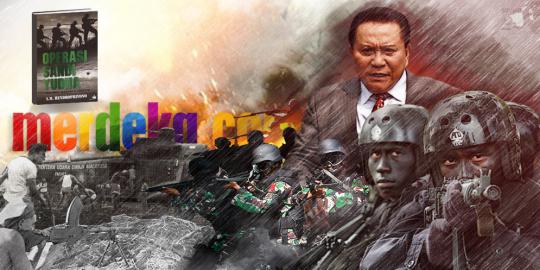The story of the irony of the military operation to crush the North Kalimantan guerrillas
Kamis, 17 Oktober 2013 01:30
Reporter :
Ramadhian Fadillah
Merdeka.com - "Think as a soldier, talk as a soldier, walk as a soldier."
General (Ret.) Abdullah Makhmud Hendropriyono launched a book entitled Operation Sandi Yudha, Crushing the Clandestine Movement. The book, published by Kompas Book Publishers, tells Hendro's combat experience as the first officer of the
Indonesian Army's Special Forces Center (now Kopassus) in North Kalimantan. There are many interesting things that Hendro wrote about in this book.
Hendro describes the political conditions after the Old Order collapsed and replaced the New Order. Many policies instantly changed 180 degrees. Including the matter of confrontation with Malaysia. In the Soekarno era, Indonesia supported the resistance of the people of Sarawak and North Kalimantan against Malaysia and
the British.
The government even trained Serawak People's Guerrilla Force (PGRS) commander Bong Kee Chok and his younger brother, Bong Hon. They are trained by
the Central Intelligence Agency, RPKAD, Marines, Air Force Mobile Force and Mobile Police Brigade. All the attention of the Indonesian government in 1964-1965 was devoted to the confrontation with Malaysia.
The government also supplied weapons to the North Kalimantan National Army (TNKU). Even a number of elite troops of the Armed Forces of the Republic of Indonesia (ABRI) were sent as volunteers and joined the TNKU. They fought against the British commandos in the wilds of Borneo.
But when President Sukarno stepped down and was replaced by President Soeharto, policy changed drastically. The New Order accused the confrontation with Malaysia of being infiltrated by communists. The Indonesian government then stopped supporting PGRS and TNKU. They asked the PGRS guerrillas to lay down arms and stop resistance.
"Of the 838 members of the TNKU only 99 devout lay down their weapons and handed them over to the nearest
police post or army post. The remaining 739 people disobeyed. The number of unreturned weapons was at least 538, consisting of bren, stengun, rifle and pistol. In addition, there are also hand grenades made by Pindad," said Hendropriyono (p. 64).
So ABRI (Indonesian Armed Force) and Polri (Indonesian Police-they have paramilitary units) were sent back to North Kalimantan, but this time to fight their own students who used to be trained to fight against neocolonialism. The PGRS and Paraku guerrillas who were in the forests did not know this.
After knowing that they now have to face each other, the members of PGRS, TNKU, ABRI and Polri were many who burst into tears and hugged each other before they declared their separation. But as a tool of the state, the arduous task still has to be done by ABRI and polri.
"The fact that politics often makes the tools of the state carry out tasks with a very heavy mental burden. This political turnaround is so painful, that their sense of humanity is washed away in a very deep current of disappointment," hendro explained.
PGRS is a disciple of the ABRI soldiers. Fought together against the British in North Kalimantan and Serawak. Now the teacher has to kill the students' own children. PGRS had to fight its own highly respected and beloved teachers. It's all because of Indonesia's political turnaround in making peace with Malaysia.
So even though it was bitter, the teacher and the student faced each other in the jungle of Borneo. It is not easy to fight PGRS who know the guerrilla terrain very well and have the support of the community. ABRI trains them well so that PGRS troops understand intelligence, guerrilla concepts, and attack silently and coordinated.
In 1967 the PGRS led by Lim Fo Kui alias Lin Yen Hoa and Bong Khe Chok held a meeting with the Indonesian Communist Party (PKI) under the leadership of S.A Sofyan and Tan Bu Hiap in Bukit Bara, east of Sambas, West Kalimantan. They formed a coalition of struggles called BaRA or Barisan Rakyat. One of the points of agreement, the PGRS would establish an independent communist state of Sarawak. A new army called the North Kalimantan People's Army (Paraku) was established.
The toughness of PGRS/Paraku was proven when they attacked the Indonesian Air Force's Singkawang II Base in Sangau Ledo. This operation went very well. They managed to seize 153 guns of AURI of various types. The attack was well planned, coordinated and neat. They practice what ABRI teaches them.
"This is something that is only commonly done by highly trained regular commandos. Not like by irregular guerrilla forces," Hendro praised.
The Indonesian government was also surprised by the success. In return, Mabes ABRI held Operation Bersih II. The Tanjungpura XII Military Command troops are now strengthened by the Indonesian Army Puspassus unit.
The teacher's war against the students flared up. Poignant, but it must be done.
[Ian]
Mereka berjuang bersama melawan Inggris di Kalimantan Utara. Kini guru harus membunuh anak-anak murid sendiri.,TNI,Operasi Sandi Yudha

www.merdeka.com





